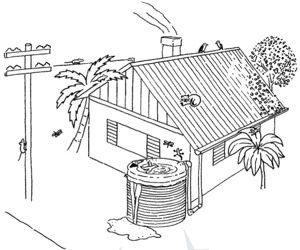With so many techniques and case-studies for building rainwater catchment systems available, it’s a wonder why we have to suffer water shortages in the Philippines.
The University of Hawaii College of Tropical Agriculture and Human Resources has detailed guidelines on building a rainwater catchment system. Since the Philippines faces similar environmental challenges, many of the recommendations can apply to us.
The document covers practical areas such as:
- Design and building materials to be used
- Types of water tanks
- Placement of water runoff to avoid undermining foundations
- Dealing with water contamination from dead animals, organic decomposition and acid rain
- Water treatment and testing
You can download the document from their website.

Preventing mosquito infestation
Mosquito breeding and infestation is a major concern in tropical climates like the Philippines. Nonoy Oplas commented on our Prepare Manila Facebook group, “Some [Philippine] households use the basic tech–which are huge drums storing rain water. Problem is that after just a few days, mosquitoes invade these drums, and thousands of new mosquitoes will come out a few days after, and malaria, dengue, other mosquito-borne diseases can expand.”
The first-flush diverters, screens and gutter guards detailed in the document are supposed to help prevent mosquito infestation. Philippine versions are probably prone to mosquito breeding because they rarely use these additions. Also, local maintainers may lack basic education and housekeeping practices. In almost any city, town and village, I see many sources of standing water where people don’t bother to clear up buckets and junk like tires, old plastic containers and boxes.
According to my research, there are some simple practices for preventing mosquitoes from breeding:
- Emptying any water holding containers
- Regularly cleaning gutters
- Fitting rain heads, flap valves and mesh gutter guards
- Installing a first flush water diverter to help prevent particles, eggs and larvae from reaching the main system
- Using mesh screens and ensuring they’re in good repair
- Using mosquito repellants such as citronella grass
This video from Rainharvesting.com gives an overview of these practices.

engineer775 on YouTube shows his setup with some enhancements to make the water potable, like a skimmer to remove particles. He also demonstrates how the first flush water diverter operates.